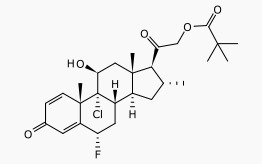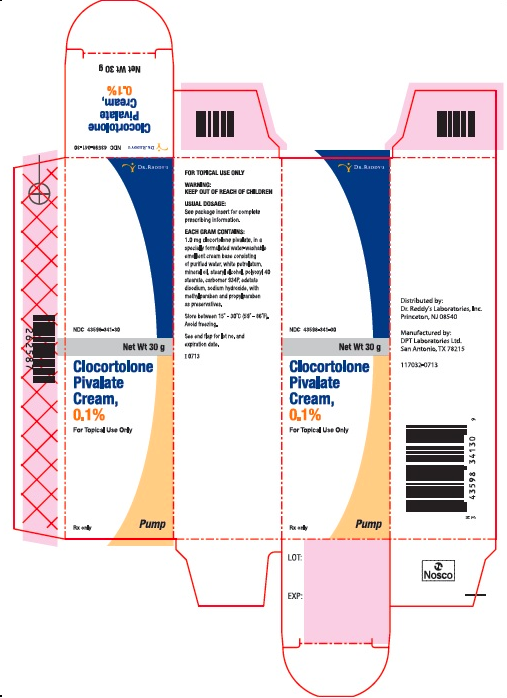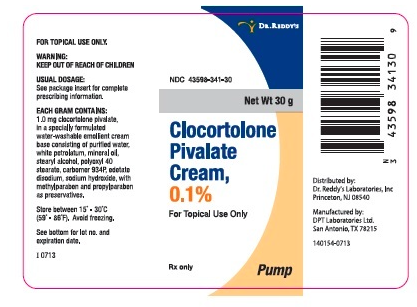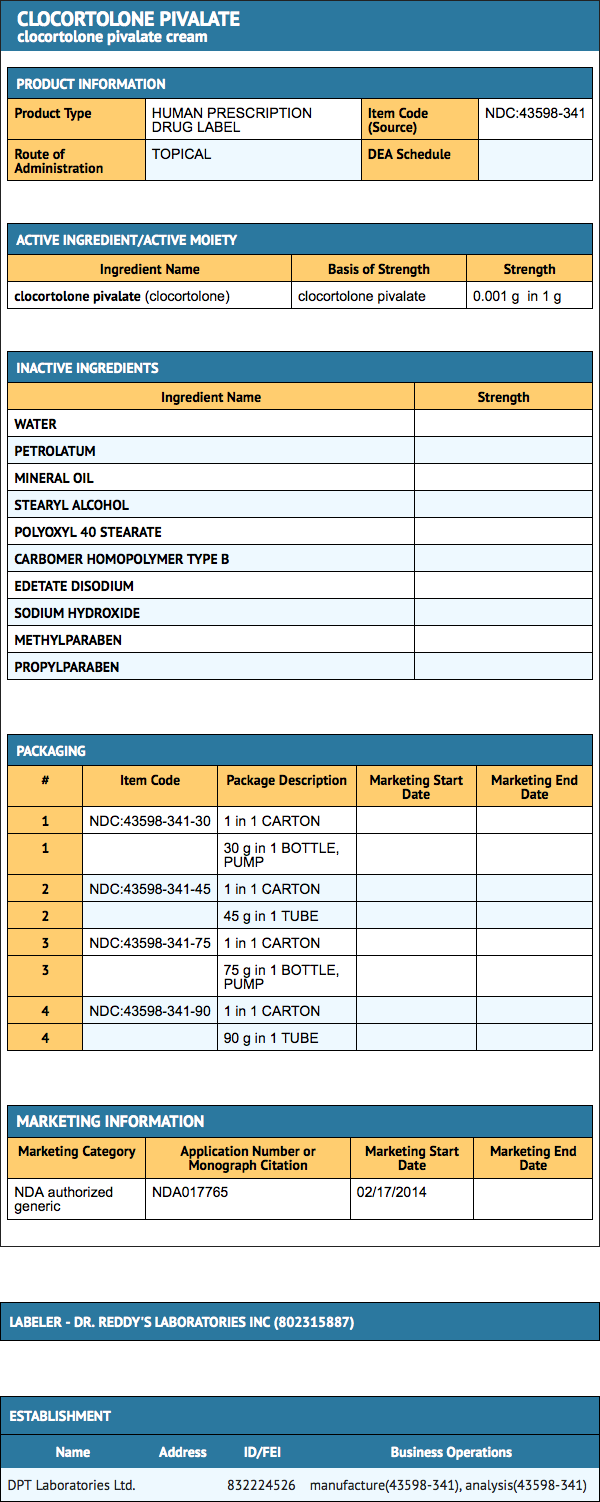Clocortolone pivalate
Editor-In-Chief: C. Michael Gibson, M.S., M.D. [1]; Associate Editor(s)-in-Chief: Alberto Plate [2]
Disclaimer
WikiDoc MAKES NO GUARANTEE OF VALIDITY. WikiDoc is not a professional health care provider, nor is it a suitable replacement for a licensed healthcare provider. WikiDoc is intended to be an educational tool, not a tool for any form of healthcare delivery. The educational content on WikiDoc drug pages is based upon the FDA package insert, National Library of Medicine content and practice guidelines / consensus statements. WikiDoc does not promote the administration of any medication or device that is not consistent with its labeling. Please read our full disclaimer here.
Overview
Clocortolone pivalate is a corticosteroid that is FDA approved for the treatment of inflammatory and pruritic manifestations of corticosteroid-responsive dermatoses. Common adverse reactions include dry skin, pruritus, burning sensation and irritation symptoms.
Adult Indications and Dosage
FDA-Labeled Indications and Dosage (Adult)
- Apply Clocortolone Pivalate Cream 0.1% sparingly to the affected areas three times a day and rub in gently.
- Occlusive dressings may be used for the management of psoriasis orrecalcitrant conditions.
- If an infection develops, the use of occlusive dressings should be discontinued and appropriate anti-microbial therapy instituted.
Off-Label Use and Dosage (Adult)
Guideline-Supported Use
There is limited information regarding Off-Label Guideline-Supported Use of Clocortolone pivalate in adult patients.
Non–Guideline-Supported Use
There is limited information regarding Off-Label Non–Guideline-Supported Use of Clocortolone pivalate in adult patients.
Pediatric Indications and Dosage
FDA-Labeled Indications and Dosage (Pediatric)
There is limited information regarding Clocortolone pivalate FDA-Labeled Indications and Dosage (Pediatric) in the drug label.
Off-Label Use and Dosage (Pediatric)
Guideline-Supported Use
There is limited information regarding Off-Label Guideline-Supported Use of Clocortolone pivalate in pediatric patients.
Non–Guideline-Supported Use
There is limited information regarding Off-Label Non–Guideline-Supported Use of Clocortolone pivalate in pediatric patients.
Contraindications
- Topical corticosteroids are contraindicated in those patients with a history of hypersensitivity to any of the components of the preparation.
Warnings
- Systemic absorption of topical corticosteroids has produced reversible hypothalamic-pituitary-adrenal (HPA) axis suppression, manifestations of Cushing’s syndrome, hyperglycemia, and glycosuria in some patients.
- Conditions which augment systemic absorption include the application of the more potent steroids, use over large surface areas, prolonged use, and the addition of occlusive dressings.
- Therefore, patients receiving a large dose of a potent topical steroid applied to a large surface area or under an occlusive dressing should be evaluated periodically for evidence of HPA axis suppression by using the urinary free cortisol and ACTH stimulation tests. If HPA axis suppression is noted, an attempt should be made to withdraw the drug,to reduce the frequency of application, or to substitute a less potent steroid.
- Recovery of HPA axis function is generally prompt and complete upon discontinuation of the drug. In frequently, signs and symptoms of steroid withdrawal may occur, requiring supplemental systemic corticosteroids.
- Children may absorb proportionally larger amounts of topical corticosteroids and thus be more susceptible to systemic toxicity.
- If irritation develops, topical corticosteroids should be discontinued and appropriate therapy instituted.
- In the presence of dermatological infections, the use of an appropriate antifungal or antibacterial agent should be instituted. If a favorable response does not occur promptly, the corticosteroid should be discontinued until the infection has been adequately controlled.
Adverse Reactions
Clinical Trials Experience
The following local adverse reactions are reported infrequently with topical corticosteroids, but may occur more frequently with the use of occlusive dressings. These reactions are listed in an approximate decreasing order of occurrence:
- Burning
- Itching
- Irritation
- Dryness
- Folliculitis
- Hypertrichosis
- Acneform eruptions
- Hypopigmentation
- Perioral dermatitis
- Allergic contact dermatitis
- Maceration of the skin
- Secondary infection
- Skin atrophy
- Striae
- Miliaria
Postmarketing Experience
There is limited information regarding Clocortolone pivalate Postmarketing Experience in the drug label.
Drug Interactions
There is limited information regarding Clocortolone pivalate Drug Interactions in the drug label.
Use in Specific Populations
Pregnancy
- Corticosteroids are generally teratogenic in laboratory animals when administered systemically at relatively low dosage levels. The more potent corticosteroids have been shown to be teratogenic after dermal application in laboratory animals. There are no adequate and well-controlled studies in pregnant women on teratogenic effects from topically applied corticosteroids. Therefore, topical corticosteroids should be used during pregnancy only if the potential benefit justifies the potential risk to the fetus. Drugs of this class should not be used extensively on pregnant patients, in large amounts, or for prolonged periods of time.
Pregnancy Category (AUS):
There is no Australian Drug Evaluation Committee (ADEC) guidance on usage of Clocortolone pivalate in women who are pregnant.
Labor and Delivery
There is no FDA guidance on use of Clocortolone pivalate during labor and delivery.
Nursing Mothers
- It is not known whether topical administration of corticosteroids could result in sufficient systemic absorption to produce detectable quantities in breast milk. Systemically administered corticosteroids are secreted into breast milk in quantities not likely to have deleterious effect on the infant. Nevertheless, caution should be exercised when topical corticosteroids are administered to a nursing woman.
Pediatric Use
- Pediatric patients may demonstrate greater susceptibility to topical corticosteroid-induced HPA axis suppression and Cushing’s syndrome than mature patients because of a larger skin surface area body weight ratio.
- Hypothalamic-pituitary-adrenal axis suppression, Cushing’s syndrome, and intracranial hypertension have been reported in children receiving topical corticosteroids. Manifestations of adrenal suppressionin children include linear growth retardation, delayed weight gain, low plasma cortisol levels, and absence of response to ACTH stimulation. Manifestations of intracranial hypertension include bulging fontanelles, headaches, and bilateral papilledema.
- Administration of topical corticosteroids to children should be limited to the least amount compatible with an effective therapeutic regimen.Chronic corticosteroid therapy may interfere with the growth and development of children.
Geriatic Use
There is no FDA guidance on the use of Clocortolone pivalate in geriatric settings.
Gender
There is no FDA guidance on the use of Clocortolone pivalate with respect to specific gender populations.
Race
There is no FDA guidance on the use of Clocortolone pivalate with respect to specific racial populations.
Renal Impairment
There is no FDA guidance on the use of Clocortolone pivalate in patients with renal impairment.
Hepatic Impairment
There is no FDA guidance on the use of Clocortolone pivalate in patients with hepatic impairment.
Females of Reproductive Potential and Males
There is no FDA guidance on the use of Clocortolone pivalate in women of reproductive potentials and males.
Immunocompromised Patients
There is no FDA guidance one the use of Clocortolone pivalate in patients who are immunocompromised.
Administration and Monitoring
Administration
There is limited information regarding Clocortolone pivalate Administration in the drug label.
Monitoring
There is limited information regarding Clocortolone pivalate Monitoring in the drug label.
IV Compatibility
There is limited information regarding the compatibility of Clocortolone pivalate and IV administrations.
Overdosage
- Topically applied corticosteroids can be absorbed in sufficient amountsto produce systemic effects
Pharmacology

| |
Clocortolone pivalate
| |
| Systematic (IUPAC) name | |
| [2-(9-chloro-6-fluoro-11-hydroxy- 10,13,16-trimethyl- 3-oxo-7,8,11,12,14,15,16,17- octahydro- 6H-cyclopenta[a]phenanthren-17-yl)- 2-oxo-ethyl] 2,2-dimethylpropanoate | |
| Identifiers | |
| CAS number | |
| ATC code | D07 |
| PubChem | |
| DrugBank | |
| Chemical data | |
| Formula | Template:OrganicBox atomTemplate:OrganicBox atomTemplate:OrganicBoxTemplate:OrganicBoxTemplate:OrganicBoxTemplate:OrganicBoxTemplate:OrganicBox atomTemplate:OrganicBoxTemplate:OrganicBox atomTemplate:OrganicBoxTemplate:OrganicBoxTemplate:OrganicBoxTemplate:OrganicBoxTemplate:OrganicBoxTemplate:OrganicBoxTemplate:OrganicBox atomTemplate:OrganicBoxTemplate:OrganicBoxTemplate:OrganicBoxTemplate:OrganicBoxTemplate:OrganicBoxTemplate:OrganicBoxTemplate:OrganicBox |
| Mol. mass | 495.023 g/mol |
| SMILES | & |
| Pharmacokinetic data | |
| Bioavailability | ? |
| Metabolism | ? |
| Half life | ? |
| Excretion | ? |
| Therapeutic considerations | |
| Pregnancy cat. |
C(US) |
| Legal status |
[[Prescription drug|Template:Unicode-only]](US) |
| Routes | Topical |
Mechanism of Action
- The mechanism of anti-inflammatory activity of the topical corticosteroidsis unclear. Various laboratory methods, including vasoconstrictor assays, are used to compare and predict potencies and/or clinical efficacies of the topical corticosteroids. There is some evidence to suggest that a recognizable correlation exists between vasoconstrictor potency and therapeutic efficacy in man.
Structure
There is limited information regarding Clocortolone pivalate Structure in the drug label.
Pharmacodynamics
There is limited information regarding Clocortolone pivalate Pharmacodynamics in the drug label.
Pharmacokinetics
- The extent of percutaneous absorption of topical corticosteroids is determined by many factors including the vehicle, the integrity of the epidermal barrier, and the use of occlusive dressings.The extent of percutaneous absorption of topical corticosteroids is determined by many factors including the vehicle, the integrity of the epidermal barrier, and the use of occlusive dressings.
- Topical corticosteroids can be absorbed from normal intact skin. Inflammation and/or other disease processes in the skin increasepercutaneous absorption. Occlusive dressings substantially increase the percutaneous absorption of topical corticosteroids. Thus, occlusive dressings may be a valuable therapeutic adjunct for treatment of resistant dermatoses.
- Once absorbed through the skin, topical corticosteroids are handled through pharmacokinetic pathways similar to systemically administered corticosteroids. Corticosteroids are bound to plasma proteins in varying degrees. Corticosteroids are metabolized primarily in the liver and are then excreted by the kidneys. Some of the topical corticosteroids and their metabolites are also excreted into the bile.
Nonclinical Toxicology
There is limited information regarding Clocortolone pivalate Nonclinical Toxicology in the drug label.
Clinical Studies
There is limited information regarding Clocortolone pivalate Clinical Studies in the drug label.
How Supplied
- Clocortolone Pivalate Cream 0.1% is supplied in 30 gram and 75 gram pump bottles, 45 gram and 90 gram tubes:

Storage
- Store Clocortolone Pivalate Cream 0.1% between 15° and 30°C (59° and 86° F). Avoid freezing.
Images
Drug Images
{{#ask: Page Name::Clocortolone pivalate |?Pill Name |?Drug Name |?Pill Ingred |?Pill Imprint |?Pill Dosage |?Pill Color |?Pill Shape |?Pill Size (mm) |?Pill Scoring |?NDC |?Drug Author |format=template |template=DrugPageImages |mainlabel=- |sort=Pill Name }}
Package and Label Display Panel



{{#ask: Label Page::Clocortolone pivalate |?Label Name |format=template |template=DrugLabelImages |mainlabel=- |sort=Label Page }}
Patient Counseling Information
There is limited information regarding Clocortolone pivalate Patient Counseling Information in the drug label.
Precautions with Alcohol
Alcohol-Clocortolone pivalate interaction has not been established. Talk to your doctor about the effects of taking alcohol with this medication.
Brand Names
Look-Alike Drug Names
There is limited information regarding Clocortolone pivalate Look-Alike Drug Names in the drug label.
Drug Shortage Status
Price
References
The contents of this FDA label are provided by the National Library of Medicine.